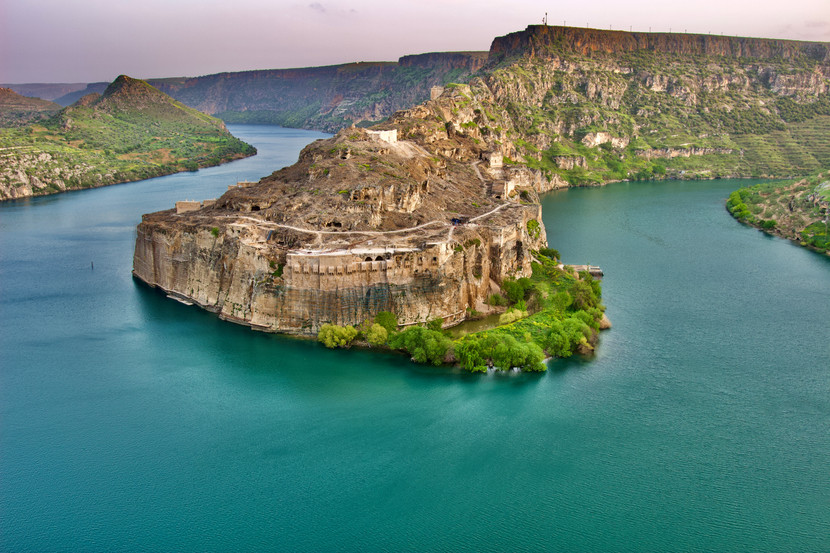Mesopotamian Meditations: Dispatches from East Turkey
- GS
- Apr 29, 2022
- 6 min read
Updated: Apr 12, 2024
In our lives we are on a constant journey of self-reflection, often unwitting pilgrims on the path to personal discovery. It is on a recent trip to Turkey’s southeast that I was confronted with the very origins of civilization – and in the process, questioned everything I thought I knew about where we come from.
When we travel, we tend to divide the past into periods. This is the history of grade school textbooks we are all familiar with: a narrative arc that frames human progress in a straight, steady line, beginning vaguely with ancient Rome, passing through the French Revolution, and ultimately coalescing into the globalized world order that we know today. This simplified account helps us to make sense of the world around us. But deep in Mesopotamia, I was confronted with proof that civilization is much older – and was much more sophisticated – than this interpretation of history has us believe. Here, we talk not about centuries or even millennia, but about eons, on orders of magnitude that defy the imagination.
Following the last Ice Age, as the globe heated up over millennia, the Fertile Crescent began to foster the ideal conditions that allowed for the world’s first organized societies to emerge.
Our story begins in Göbekli Tepe, long before the invention of pottery, agriculture, and the wheel. In the mid-1990s, as part of his ongoing research into the area, archaeologist Klaus Schmidt chose to excavate a site that had previously been dismissed as an insignificant Byzantine graveyard. As he dug deeper, he knew that he had unearthed something of monumental importance. In just a few years, his discovery atop a simple hill in Anatolia would come to change our fundamental understanding of human civilization.
Schmidt and his team quickly determined the site to be 11,500 years old: 7,000 years older than the pyramids of Egypt and 6,500 years older than Stonehenge. This means that we live closer in time to the building of the pyramids than the building of the pyramids exists in relation to Göbekli Tepe. While the pyramids of Egypt were built about 45 centuries ago, Göbekli Tepe was established over 115 centuries before our time. On top of all that, the radiocarbon dating from the site dates from between 9500 BCE and 8000 BCE – meaning that the site was continuously inhabited for about 1,500 years.
This has challenged all of our previously held assumptions about the origin of our species. Göbekli Tepe is the focal point of a puzzling question. It either means that hunter-gatherers were capable of far more than we had previously imagined – building massive monolithic temples for worship over a wide area – or, the agricultural revolution took place over a thousand years before what we had originally presumed, and there may be a host of other similar sites that we have yet to discover. Whatever the case, Göbekli Tepe is ground zero for the debate between those who think that settling down is what led to the invention of agriculture, and those who think that agriculture predates settled society. The existence of these megalithic temples doesn’t simply push back the timeline of civilization by millennia: it also contradicts much of our conventional wisdom about human ingenuity, progress, religion, and technology.
Still today, there is so much that we don’t know. We don’t quite know how the site was built, who lived there and why, or how extensive the site actually is. But before his death in 2014, Schmidt estimated that only five percent of the entire site had actually been excavated. It is clear that we still have much to learn from this structure: the zero point in time and a true temple to humanity.
A short drive southwest of Göbekli Tepe sits the ancient city of Şanlıurfa. Before, it was simply known as Urfa, but following the city’s critical role in repelling the French in the Turkish War of Independence, Şanlı – glorious – was added in order to pay homage to its fallen heroes. Glorious Urfa indeed: strolling around at sunset, I ducked into a mosque to hear the call to prayer as the whole city sat down to break fast for Ramadan. Towards the back of the mosque, I found a small cave, and above the entrance was an ordinary panel describing an extraordinary place: it was the birth cave of Prophet Abraham, patriarch of three major world religions.
Seven thousand years and a mere 20 kilometers: this is what separates Göbekli Tepe, humanity’s first known permanent structure, from Urfa, the birthplace of Abraham. The first monolith and the first prophet. This small stretch of land covers such a long and rich history it is nearly impossible to convey.
I invite the reader to come with me to Gaziantep. Much like Urfa, this city was previously referred to simply as Antep. The post-War of Independence addition of Gazi elevated humble Antep to Gaziantep: “Antep the war hero.”
A global center for the production of pistachios, in Turkish the nut derives its name – antep fıstığı, or antep nut – from this very city. In most other parts of the world, pistachios are considered a luxury item. Here, they are chopped, crushed, powdered, and sprinkled on every dish and dessert like gold dust. Little wonder, then, that Gaziantep is considered the world capital of baklava, as well as the culinary capital of Turkey.
They say the gastronomy alone makes this city worth a visit, and boy, did it not disappoint. Every chophouse, hole in the wall, and eatery served up the finest fare, exceeding even the most serious food I’ve ever had in Istanbul. Turkish food is already mouth-watering, but the capital of Turkish cuisine elevated my taste buds to a higher plane.
Nearly every restaurant boasted the same sign: Dünya bir ev olsaydı, mutfağı Gaziantep olurdu: “If the world was a house, Gaziantep would be its kitchen.” And it’s not such a far-fetched statement to make. Although it’s not quite Paris or New York in terms of culinary world capitals, Gaziantep lies squarely in the heart of a region that first mixed Greek, Arab, Persian, Turkish, Central Asian, and Mediterranean food to create the world’s original “fusion cuisine,” long before the first foodie hipster invented the term.
Gaziantep is also home to the Zeugma Mosaic Museum – the world’s largest mosaic museum. (Incidentally, I’ve also been to the second largest mosaic museum, the National Bardo Museum in Tunisia.) An important city and military outpost for the ancient Romans, Zeugma had been sporadically excavated in the latter half of last century until the Turkish government’s decision in 2000 to build Birecik Dam threatened to flood the entire site. At the behest of philanthropist David Packard (of Hewlett-Packard fame), an emergency excavation was conducted, and these priceless artefacts were saved from being lost to history forever.
Many of these mosaics are of such high quality that they resemble paintings. The craftsmen who painstakingly put these together piece by piece had mastered the play between light and the body. With soft light hitting off of the musculature of the calf or shoulders, for example, in specific ways these artists could bring a flat surface to life by rendering a 3-D effect to their mosaics. I could see a direct line between these mosaics and Rembrandt’s study of light, or Da Vinci’s masterful paintings, informed by his deep understanding human anatomy.
After the Sack of Rome, as Europe was plunged into the Dark Ages and lost this knowledge, artistry in the west would not meet this level of sophistication for perhaps another thousand years. These masterpieces serve as yet another reminder as to why the titans of the Renaissance looked towards the Ancient Greeks and Romans for inspiration.
At nearby Rumkale, a fort perched above a strategic chokepoint of the river Euphrates, I marveled at the ability of our forefathers to create feats of engineering from impenetrable rock. Inhabited since the paleolithic age, Rumkale has been occupied over millennia by the Assyrians, Babylonians, Persians, Romans, and Ottomans.
It is from here that John the Apostle, one of the twelve apostles of Jesus, first spread Christianity throughout the region. Tradition has it that during the Roman era, John used the fort as his home base to reproduce copies of the bible, and then took those bibles to Beirut to spread the gospel.
We ended the trip in Mardin, a sandy-colored outpost near the Syrian border, long the center of Assyrian culture. Assyrians are an ethnic group that trace their roots back about 25 centuries, and were one of the first peoples in the region to convert to Christianity. Even today, Assyrians still speak an offshoot of Aramaic – the language spoken by Jesus – and follow the traditions of the Syriac Orthodox Church.
A fortified city rising dramatically on a hill above the Anatolian plateau, Mardin is host to a mesmerizing mix of cultures. Ancient monasteries vie for space with medieval mosques, while shopkeepers in the bazaar speak in equal parts Kurdish, Turkish, and Arabic. Old men sit on little stools and count their prayer beads, while children run through the dusty, labyrinthine streets. Charming caravanserais and cozy little inns provide a window into the city's past as a key trade center along the Silk Road.
Our hotel was an elegantly restored 12th-century palace, with stately doorways, vaulted arches, and kaleidoscopic stonemasonry in the Islamic tradition. I sat on the balcony, bathed in red light from the setting sun over the Mesopotamian plains below, and tried to take it all in. This truly is the cradle of civilization – where everything began, and where history fades into nothingness.



















































Fantastic 😍 - Els